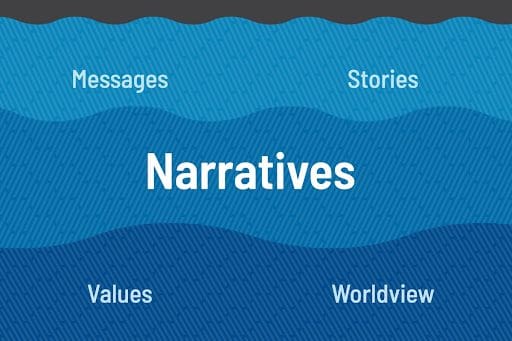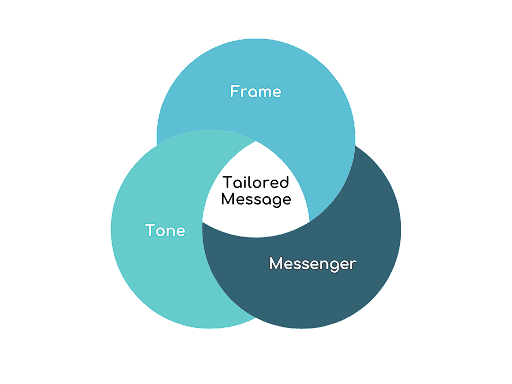The age old communications motto – “When you try to talk to everyone, you talk to no one” is true! But what does that actually mean and how can you put this philosophy into practice?
TLDR? You don’t have to start from ground zero. Playing with frame, tone, and messenger allows you to adapt your communications to connect with different audiences.
Watch our recent webinar below or read on for the highlights.
The Waves Model
When similar stories are shared multiple times over time, that collection of stories starts to represent something much deeper– a narrative. These narratives become more deeply ingrained into culture, which shapes our values and worldviews, becoming these broad insights into our shared community and identity.
When we’re thinking about our audiences, we should think about the stories that the audience is responsive to, the narratives that those stories have created, and the values and world views that the audience may hold.

Understanding your audience
Your narrative change project has to reach its intended audience — the individuals or groups whose behavior you want to change or mobilize — to have impact. We get specific about who the audience is by identifying their shared traits (age, gender, language, geography, where they live, how they get information) so we can understand their wants and needs and use the best framing, imagery, and words to move them to act.
The Audience Profile Worksheet as a tool to help us answer these questions. In a lot of ways, we’re making our best guesses as we work through this exercise, but we can look to census data, digital analytics, polling data, media reports, market research, and our own knowledge about ourselves, friends, family, and community to inform our strategy.
Tailoring your message
There are three main variables that can impact how your audience receives your messaging: frame, tone, and messenger.

Frame
A frame is like eyesight. Some people have 20/20 vision, some need prescription lenses and some have had Lasik surgery. The lens through which you see the world is unique to you, based on your worldview and the environment around you, and impacts how you take in and filter new information.
Framing of issues (for example, talking about an issue as personal vs. shared responsibility) will hit differently based on your lived experience. We try to lean into frames that put our audience in the best possible state to work with us and avoid messages that land us in frames that are counterproductive, by tapping into shared values. Some powerful frames we see in water communications are water as a human right, the intrinsic value of healthy ecosystems, and the idea that we should all have a voice in water decisions that affect us.
Tone
Did you present your information playfully or factually? Were you serious, rightfully outraged, sarcastic, or earnest? The words and language you choose for a message can encourage the audience to feel the same way. Tone lends personality and credibility to a message, and a well-suited tone establishes a connection with the audience – making the message relatable and trustworthy, or motivating the audience to jump into action.
For example, the Water Hub’s main audience is water justice partners, so our organizational voice is intentionally collegial, friendly, and informative. With that in mind, we play with tones that are direct, professional, and hopeful in our communications without getting overly technical or doomsday-eque because we know that resonates with our audience and feels authentic for our organization.
Messenger
Messengers matter just as much as the message itself. They should be trusted, authentic, and, if possible, reinforce the frame. The messenger may be you and your organization or you may be looking to outside validators to bring additional credibility. For example, the same public health message will resonate differently coming from a politician or economist compared to a nurse or health professional. Hearing from a directly impacted community member can help put your audience in their shoes and think about what’s at stake for their own family.
Messaging across ideology
Lastly, we covered some considerations for messaging across ideology. It can feel like there are brain blocks in place that prevent people from engaging when they’re mired in “what side” they’re on or feeling a lack of trust in institutions. We’re always going to get further by framing issues around shared values rather than technocratic policy. So while we know we won’t, and don’t need to, win everyone over, starting with a message that taps into a vision of shared opportunity, voice, and security (that we should all have the tools to meet our own basic needs and the needs of our families) is a great place to start.
Trying to get specific about your audience doesn’t mean leaning into stereotypes. For example, rural does not just mean redneck and republican. Instead, we can lean into the opportunity to tell stories that reflect shared values and celebrate another story about rural places: stories of community care, civil rights victories, and the rich history of mutual aid.
Lastly, water is a total winner! While concern and alarm about the climate crisis is growing, and educating and mobilizing those who are worried, concern about water and support for clean water safeguards remains strong across political ideology and all demographics.
What’s next?
To stay in the loop for other Water Hub trainings and resources, join our newsletter list. You can also follow us on Twitter, LinkedIn, and YouTube.
